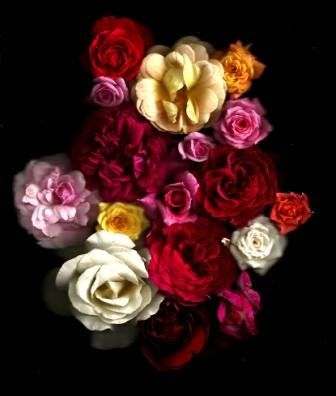For all those poor souls who, like me, sadly have the artistic ability of a donkey no matter what the canvas, I've got to show my first results with a new technique; using a computer and scanner to create collages with my garden bounty.
I became aware of scanner photography through the GardeningGoneWild Bloom Challenge website which had wonderful examples and was itself linked to a blog containing the works of photographer David Perry titled A Photographer's Garden Blog. The breadth of possibilities and expression demonstrated on Perry's blog inflamed my obsessive-compulsive nature and, although pausing for supper, I spent the evening after my discovery choosing flowers and vegetation and trying the technique out my home scanner, and after a little photo editing, I created, among many others, the images here.
You've just got to try this technique out. To get started, you need only a computer, scanner, and some garden material and after that, the sky is the limit. Literally. As far as tips go, I've already got a few from my brief experience:
a) Use only perfect blooms and foliage; the scanner will pick up every little imperfection.
b) Keep the scanner surface perfectly dust- and streak-free. Again, any defect will mar the final picture.
c) The only perfectly focused items will be right on the scanner surface. Items and blooms even slightly off the surface quickly lose focus.
d) For pictures without a background, keep the room lights off and do the scanning at night to get a background that a little photo manipulation will turn to seamless black.
e) You can try colored or patterned backgrounds, but in practice, I found it tough to make the textures of these backgrounds fit the pictures.
f) The photo editing software need not be sophisticated, but you will need some editing capability. I used Microsoft Office Picture Manager for these pictures.
Give it a shot; you'll amaze yourself and stun the friends and family who've given up on ever seeing your artsy side!



+comp.jpg)

+comp.jpg)